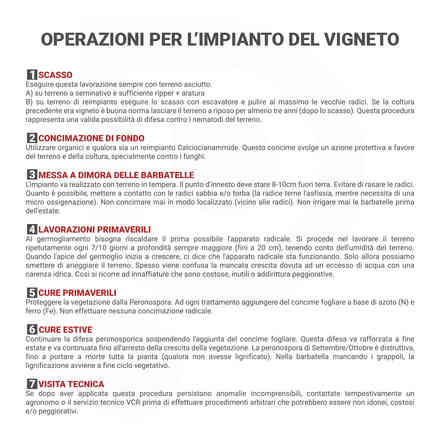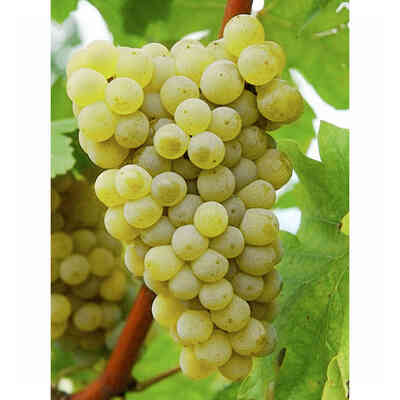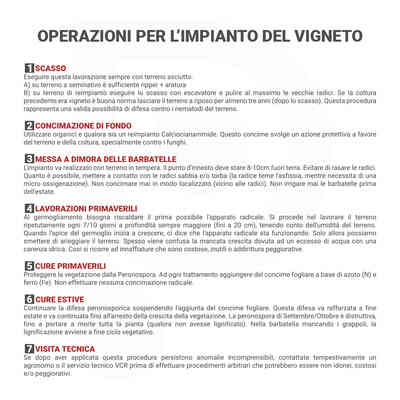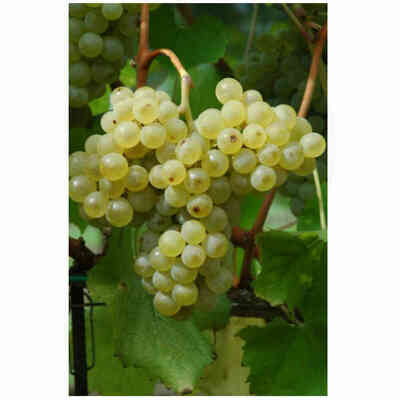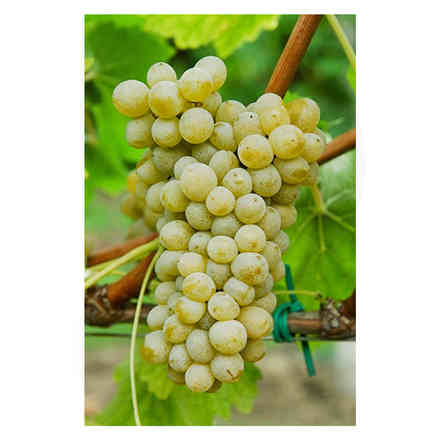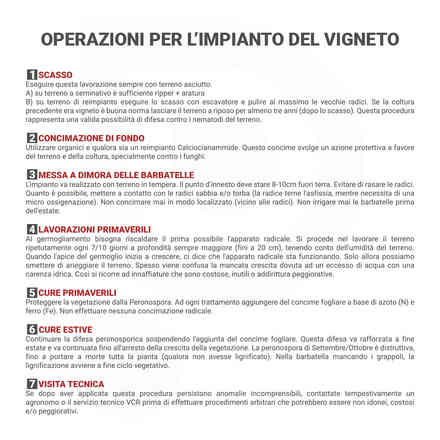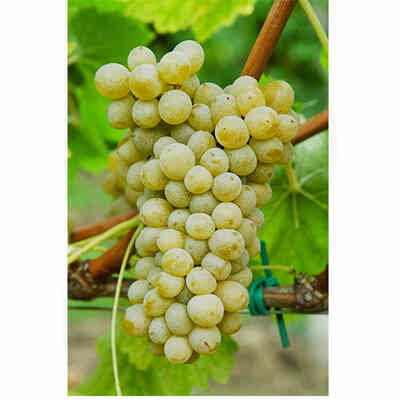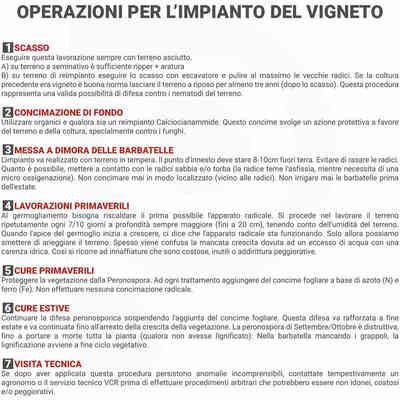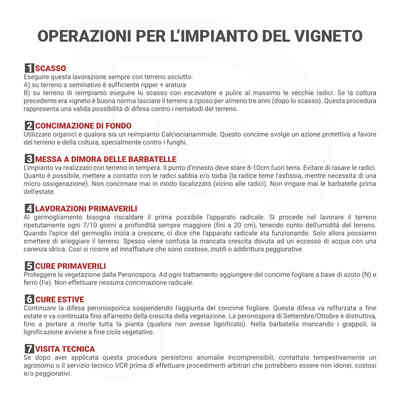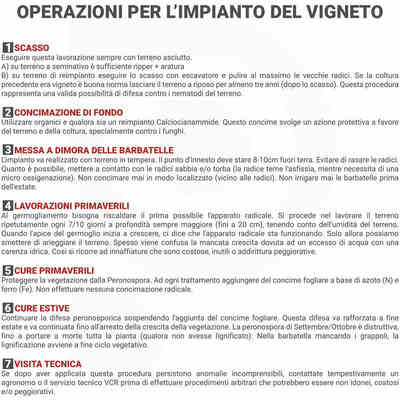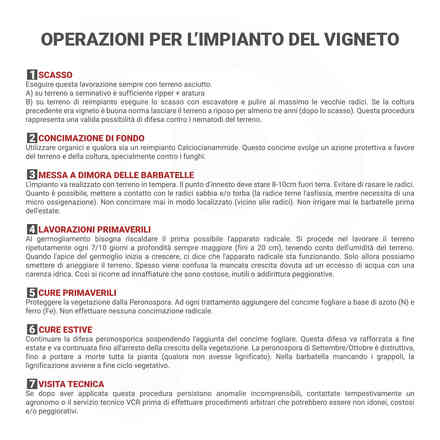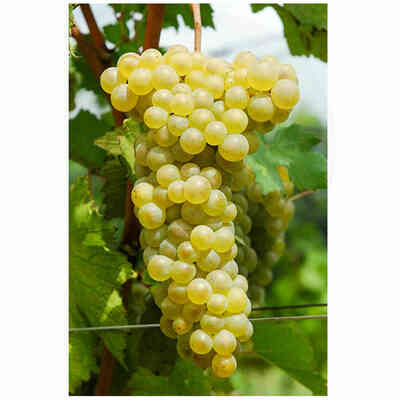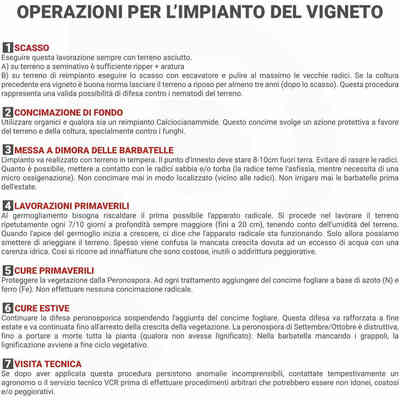Pampanaro (10 pcs)
Description
 AUTHORIZED RETAILER
AUTHORIZED RETAILER
PAMPANARO (10 PZ)
Rootstocks: 1103P - K5BB - S04 - 140RU - 420A (We will send the graft carrier available at the time)
The vine has been cultivated in the Frusinate area since time immemorial. The census of agricultural resources (Atti dell'Inchiesta Parlamentare sullo stato dell'agricoltura del neonato Regno d'Italia 1877-1884) lists it as a variety commonly grown in the area.
MORPHOLOGICAL DESCRIPTION
- Plant: open shoot apex, greenish with yellowish reflections, sometimes bronzed. Shoot habit: semi-erect.
- Leaf: medium-large, pentagonal, five-lobed, sometimes three-lobed with eave profile and smooth upper side; open V-shaped petiolar sinus with slightly overlapping lobes; closed U-shaped upper lateral sinuses.
- Berry: medium, round, thick-skinned, fairly firm, fairly pruinose; yellow with greenish highlights; moderately firm flesh with a neutral flavour; average berry weight 2.16 g.
- Bunch: medium-large, pyramidal, averagely compact; average bunch weight 225 g.
PHENOLOGY
Sprouting in the third ten days of March/first ten days of April; flowering in the third ten days of May; veraison in the third ten days of July; harvesting in the third ten days of September.
AGRONOMIC CHARACTERISTICS
Variety characterised by remarkable rusticity and good vigour. It is able to adapt to various environmental conditions, growing without problems both in moderately compact soils and in calcareous soils with the presence of skeleton. In the past it was grown in pairs with elm trees: even today there are scattered vines grown in the testucchio style. Most of the vines are free-standing. It is normally grown as a simple espalier in mixed cultivation. Traditional spurred cordon pruning with a maximum of 10 buds; fertilisation with manure; the use of mineral fertiliser is very limited.
In the growing area, vine-growers distinguish between a small-berry Pampanaro and a large-berry Pampanaro; ampelographic and phenological observations and chemical-physical analyses of the wine have not revealed differences that justify the recognition of two distinct clones. The slight difference in berry size is probably due to pedo-climatic and not genetic factors.
- Production: productive.
- Average number of inflorescences per bud: one to two.
- Disease resistance: normal for downy mildew, powdery mildew and botrytis.
TECHNOLOGICAL AND ORGANOLEPTIC CHARACTERISTICS
Chemical characteristics of the wine:
- Alcohol content 11.65-13.32 vol %.
- pH 3.27-3.48
- Total acidity 5.00-6.17 g/l
- Volatile acidity 0.15-0.46 g/l
Juice characteristics:
- Average pH 3.22
- Average sugar content 21,35
- Total acidity 5,92 %.
A wine of a deep straw yellow colour with greenish reflections, with a consistent acidic structure, good body and excellent aromatic tones of flowers and fruit.
RULES TO PLANT A VINEYARD
1. PLOW
You must perform this operation always with dry soil
A) On arable land is generally sufficient to ripper + to plow
B) On planting soil is generally sufficient to plow with an escavator and to clean the old roots.
If the previous crop was a vineyard, it is a good idea to leave the soil fallow for at least three years (after plowing). This procedure represents a valid possibility of defence against soil nematodes.
2. SOIL FERTILIZATION
Use organics and if it is a reimplantation, use Calciumocyanamide.
This fertiliser has a protective effect on the soil and the crop, especially against fungi.
3.PROPAGATING GRAPE VINE CUTTINGS
The planting should be carried out in temperate soil. The grafting point should be 8-10 cm above ground. Avoid shaving the redices. As much as possible, put sand and/or peat in contact with the roots (the root fears asphyxiation, while it needs a micro-oxygenation). Never fertilize in a localized manner (near the roots). Never water the rooted cuttings before summer.
4.SPRING WORKS
When sprouting, the root apparatus must be heated as soon as possible. Work the soil repeatedly every 7/10 days at increasing depth (up to 20 cm), taking into account the moisture of the soil. When the apex of the bud starts to grow, it means that the root system is functioning. Only then can we stop watering the soil. Failure to grow due to access to water is often confused with a lack of water. This is why watering is used which is expensive, useless or even worse.
5.SPRING CURE
Protect vegetation from Peronospora. To each treatment add nitrogen (N) and iron (Fe) foliar fertilizer. Do not make any radical fertilization.
6.SUMMER CURE
Continue with the defense against Peronospora by suspending the addition of the foliar fertilizer. This defense should be reinforced in late summer and should be continued until vegetation growth stops.
The September/October blight is destructive, to the point of bringing death to the whole plant (if it has not lignified). The rooted vine lacks clusters, so lignification occurs at the end of the vegetative cycle.
7.TECHNICAL VISIT
If incomprehensible anomalies persist after this procedure, contact an agronomist or the VCR Technical Service promptly before carrying out arbitrary procedures which may be unsuitable, expensive and/or worsening.






















